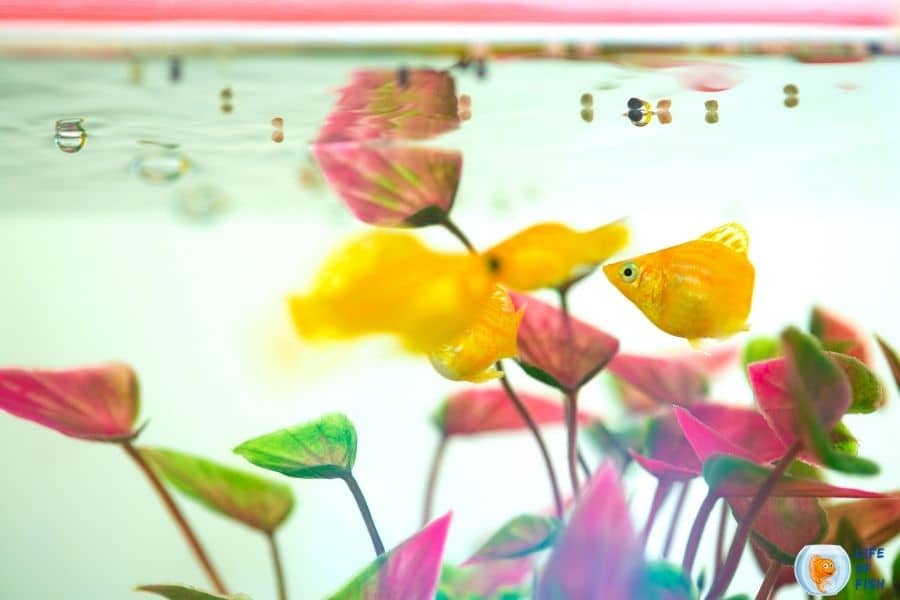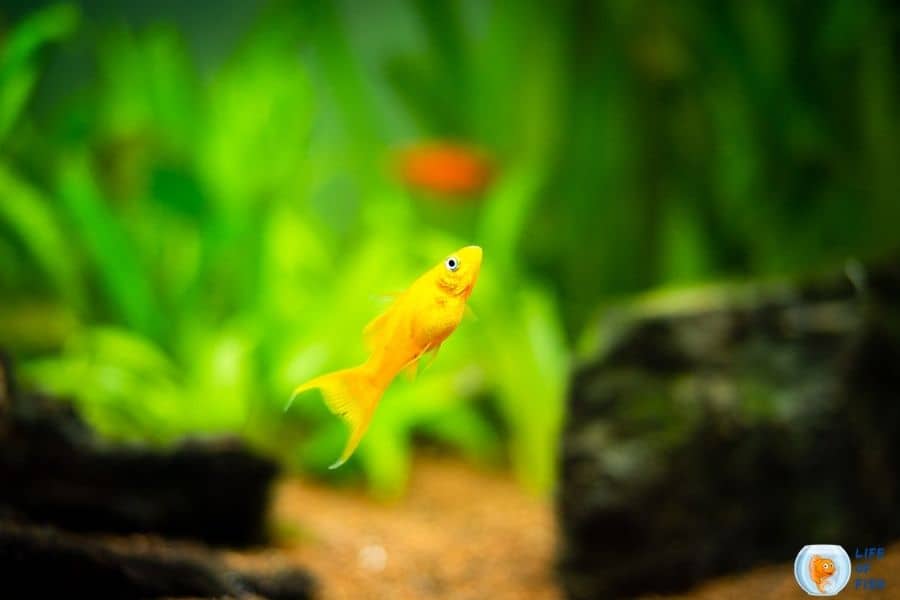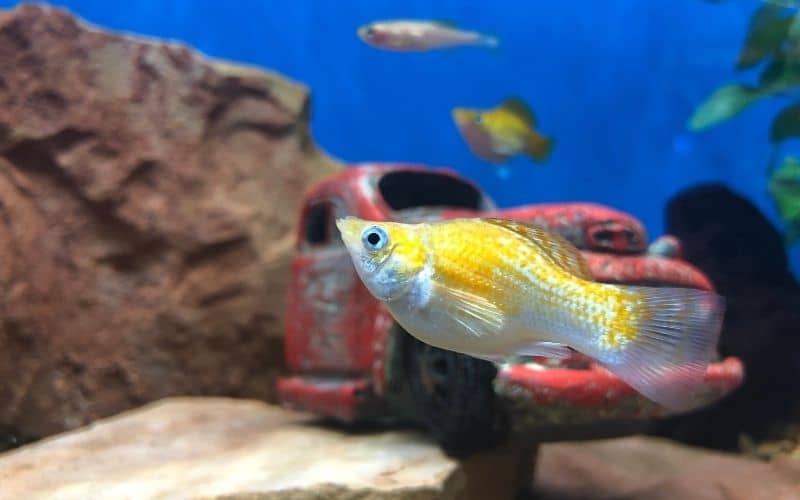Molly fish are famous for their vivid colors and their undemanding nature. They are popular among beginner aquarists because of their ability to adapt quickly to a new environment.
Many people have stories of how they successfully bred mollies, and everything was going great until the babies started to die one day.
It is absolutely heartbreaking when you raise a group of fry from birth, and one day they all start dying for no apparent reason.

While most would think this is due to poor water conditions, the main reason may lie behind your molly fish feeding schedule.
Although mollies are voracious eaters, they require a precise and specific amount of food. It is essential to know the proper schedule and how much you should feed your molly fish to keep them healthy and happy.
So, let’s learn about the molly fish feeding schedule, why it’s important and how you can do it correctly.
Molly Fish Feeding Schedule
Jump To
- 1 Molly Fish Feeding Schedule
- 2 What does molly fish eat?
- 3 What should I feed my molly fish?
- 4 Can you feed molly fish goldfish food?
- 5 How often should you feed your molly fish?
- 6 Molly fish feeding time
- 7 How often do you feed baby molly fish?
- 8 Things to consider while feeding your molly
- 9 What happens if you overfeed a molly fish?
- 10 How long can mollies go without food?
- 11 Related questions
- 12 Conclusion
Feeding mollies the right amount of food is critical to their long-term health. These fish are very active swimmers and have an aggressive appetite, so you must be careful not to overfeed them.
If they eat too much, their digestive system can easily go into shock and cause serious problems that may even be fatal.
The best way to avoid this is by feeding them at the right time and offering them food that contains all of the nutrients they need. Before choosing any food, you must know what do mollies eat first.
What does molly fish eat?
In the wild
Mollies are omnivorous fish that eat just about anything they find. These fish feed on small invertebrates, algae, and even on some plant life in the wild.
In an aquarium
In an aquarium, you can feed your mollies a variety of food as long as it provides all their nutritional needs. If you want to ensure that your mollies are getting a healthy meal, you must give them a varied diet.
As mollies are voracious eaters, they will accept any food you offer, including fish pellets, flakes, frozen or freeze-dried foods, and even vegetables.
All of these foods should be part of their diet, but only in moderation because mollies already tend to overeat. This overfeeding is the main reason why these fish are often sick.
What should I feed my molly fish?
As we said before, mollies will accept just about anything if it is edible. This includes unhealthy food such as rice, bread, sweets, and even junk food.
We strongly advise you to avoid these foods at all times because mollies don’t need the extra calories, carbs, or sugars.
Instead, you should feed your fish with nutritious food like vegetables and green leafy plants. Pieces of nori seaweed are common treats for these fish, and they also love to munch on various algae.
However, most of their diet should contain protein because mollies are very active swimmers. They require plenty of protein to maintain their muscle mass, so you should provide them with food that contains it.
You can also feed your molly with high-quality fish pellets specially designed for omnivorous fish like mollies.

Can you feed molly fish goldfish food?
Since goldfish and mollies are omnivorous, mollies can eat goldfish food as part of their diet.
However, you should not replace the primary food source with goldfish food, as goldfish food contains more fiber and less protein.
Goldfish require more fiber in their diet, while mollies require more protein. So, feeding them goldfish food often can cause digestive problems.
How often should you feed your molly fish?
Mollies are very active swimmers that burn through lots of energy every day. Since food is their primary energy source, they need to eat frequently to stay healthy. However, you don’t want them to overeat because mollies get sick from overfeeding.
The best way to determine the right amount of food to feed these fish is by observing their growth and body condition.
If they are underweight or have a thin body shape, then you should feed them more often throughout the day.
On the other hand, if your fish are overweight or have a round body shape, you should feed them less often.
It’s best to feed your fish twice per day and provide them with a varied diet. This will make sure all of their nutritional needs are met, and they stay healthy and active for years to come.
Does mollie fish eat algae?
Yes, mollies love to eat algae because it’s a natural part of their diet in the wild.
If you want to provide your molly with a healthy and nutritious meal, you should regularly add algae to their diet.
In the wild, these fish eat a lot of aquatic plants and algae from surface water. High-quality algae supplements contain the same nutrients as the algae that mollies eat in the wild.
These supplements are straightforward to use and can be added directly to your aquarium.
What vegetables do mollies eat?
Mollies are herbivorous fish that require a lot of fiber in their diet.
They benefit from eating green leafy vegetables and aquatic plants because these high-fiber foods help maintain their digestive tract.
Mollies love to eat zucchini, kale, spinach, romaine lettuce leaves, bell pepper, peas, green beans, and broccoli. You should feed them these vegetables regularly in order to provide them with all the nutrients they need.
Avoid feeding mollies starchy vegetables like potatoes and corn because these foods don’t provide any nutritional value.
You can occasionally feed your fish small amounts of starchy vegetables, but it’s best to feed them sparingly because these foods are high in carbs.
Molly fish feeding time
Since mollies are diurnal species, they require a lot of energy throughout the day.
They are very active swimmers that eat constantly, so you should feed them at least twice per day during day time.
Mollies store a lot of fat in their body, so you should try to minimize their food intake during the night. Since mollies sleep most of the night and usually stop eating at around 9:00 pm, you should only feed them before that time.
Things will be easier if you feed your fish before going to work and after coming home every day. This is the easiest way to provide your fish with a healthy and nutritious diet.
How often do you feed baby molly fish?
As molly babies grow rapidly, they require more nutrition than adult mollies. Since babies grow three times faster than adults, you should feed them at least three times per day.
If they don’t eat their food within a few minutes, it is better to clean it up and feed them later.
The best time to feed your molly is early in the morning, at lunchtime, and late in the evening before you switch the lights off.
This way, you will make sure that molly babies don’t miss out on any of their meals and they stay healthy and strong.
It is better to keep some plants and algae in the tank so that your molly babies can eat them whenever they are hungry. If there aren’t enough algae, you can feed them dry food occasionally.
How many flakes to feed a molly?
Although molly fish are voracious eaters, they can eat only tiny amounts of food during mealtime. A pinch of crushed flake is enough to feed 5 to 7 mollies in a day.

Things to consider while feeding your molly
Mollies are very greedy fish, so it’s best to use a feeding tube or a feeding ring if you want to feed them efficiently. These accessories help you feed them much less food in much bigger portions.
If you want to keep your molly healthy and active, keep their feeding schedule consistent.
If you feed them too much food in one feeding, they’ll likely eat it all within a few minutes. This may cause problems with the water quality and other aquarium inhabitants.
Frequent water change is crucial as leftover food can deteriorate the water quality and lead to infections. Do a tank cleaning once or twice per week and ensure there is always enough algae and other food for your fish.
What happens if you overfeed a molly fish?
Overfeeding once or twice won’t do much harm, but when you feed them frequently, leftovers can decompose in the tank and shift the pH balance. Further, your fish may get digestive problems such as bloating and even death in extreme cases.
No matter how hungry they are, try to limit the amount of food you feed them during each feeding.
Feed your fish a little bit at a time and give them enough time to eat it all. This way, you’ll make sure that food doesn’t decompose in the tank, which may lead to water quality problems and poor health for your fish.
How long can mollies go without food?
Mollies can go without food for up to 10 days, but it is better to feed them at least once or twice during this time. Since mollies store a lot of fat in their body, they have enough reserves to survive for a while without food.
If you don’t feed them for two weeks, they may become lethargic and stop eating altogether. This means that your fish need a lot of care and attention. In this case, you should immediately feed them small amounts of food.
Related questions
Will mollies eat snails?
Yes, mollies will eat almost any type of food.
Snails can be a nutritious and healthy alternative to regular fish food, so your molly can eat snails. However, it is highly unlikely as most aquarium snails are large enough not to become prey to mollies.
Do mollies eat their babies?
Cannibalism is normal within mollies.
Fortunately, mollies rarely eat their babies. However, this may happen if your tank lacks enough food and space. Female mollies may also eat their babies if they become stressed.
Do molly fish need salt?
No. Although mollies can survive in tiny salt concentrations, salt is unnecessary for their diet and the aquarium.
If you add too much salt, it may lead to stress or illness in your fish. Remove some salt if you notice that your mollies’ skin is getting irritated or discolored.
Do mollies need a heater?
Mollies require a temperature of 25 to 28 °C (77 to 82 °F). If the temperature is too low or too high, mollies may get sick.
Choosing a heater for your molly tank with an adjustable thermostat is better. Since they require warm water all year round, a heater is a must-have accessory.
They are also susceptible to fungus infections, especially when the water is too cold or too hot. It’s also easier to set the right temperature with a heater since some aquariums are very hard to adjust to the proper temperature.
Conclusion
Molly fish has a voracious appetite, so; they will eat anything edible every time you feed them.
However, you need to control the amount of food you give them. Make sure they eat all the food within a few minutes but don’t feed them too much at once. Mollies require at least two times feeding per day, while molly babies require more feedings.
Read Next : Firemouth Cichlid Feeding ( Are You Feeding Your Fish Right? ) Blood Parrot Cichlid Food (What Should You Feed Them) Amazon Leaf Fish Feeding | 11 Essential Feeding Facts |
